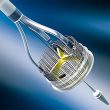Courtesy of Dr. Carlos Fava. The development of new valves for TAVR and the increased experienced of operators have significantly decreased paravalvular leak. However, new bundle Branch block (BBB) and the need for permanent pacemaker (PPM) are still relatively high, and their impact and evolution remain controversial. The study looked at 816 patients, 437...
Predictors of Conduction Disturbances Requiring a Late Permanent Pacemaker
This analysis shows that baseline right bundle branch block and increased PR length after transcatheter aortic valve replacement (TAVR) are independent predictors of advanced conduction disturbances requiring late pacemaker implantation. A simple electrocardiography can detect these potentially fatal conduction disturbances that might happen more than 48 hours after TAVR. Data from consecutive TAVR patients from...
Permanent Pacemaker: still TAVR’s Aquila’s Heel
TAVR has shown benefits in high risk patients (prohibitive) and in intermediate risk patients, but the need for permanent pacemaker implantation (PPI) continues to be a soft spot (especially in younger patients) given time of use, eventual replacement and associated complications. Even though there is little information on PPI, pacemakers are not associated with higher mortality, but they...
Development of New Valves Lowers Need for Pacemaker
Courtesy of Dr. Carlos Fava. While the benefits of TAVR are well-known, the need for a permanent pacemaker after implantation is still an issue to solve, even though new valves have reduced it. This study enrolled 175 patients who underwent TAVR with an ACURATE neo TF valve. In this population, 58% of patients were women and the...
REPRISE III: Need for Pacemaker and Paravalvular Leak with Lotus
A recent presentation at London Valves took a closer look at the REPRISE III trial as regards two points that generated much discussion, such as need for a pacemaker and paravalvular leak. REPRISE III had previously demonstrated that the Lotus is noninferior to first-generation CoreValve and Evolut R in terms of safety. Additionally, it proved to be superior...
End of Discussion on the Impact of Pacemaker After TAVR?
Transcatheter aortic valve replacement (TAVR) is often associated with conduction abnormalities, which usually end with permanent pacemaker (PPM) implantation in 10-40% of patients. Factors predisposing to PPM after TAVR have been studied in great detail, but their short- and long-term clinical impact is still controversial. Recently, outcomes from a large cohort of patients were...
Pacemaker Implantation After TAVI Raises Costs But Not the Incidence of Adverse Events
This new meta-analysis did not manage to prove whether permanent pacemaker implantation after transcatheter aortic valve replacement (TAVR) raises the rates of mortality, infarction, or stroke. Implantation could only be associated to a lesser recovery of ventricular function after the procedure, something that had already been observed in previous studies. Patients who required a pacemaker undoubtedly...
Lotus Valve performance related to pacemaker implantation in patients after TAVR
Courtesy of Dr. Agustín Vecchia. Paravalvular leak was once considered the greatest disadvantage of TAVR when compared to conventional surgery. Nowadays, new devices and more-experienced operators have managed to “control” this phenomenon, keeping related statistics within acceptable ranges. Repositionable-valve Lotus may probably offer the most effective solution for this event; however, it is associated with high rates of...
Permanent Pacemaker Predictors with SAPIEN 3
The aim of this study was to identify permanent pacemaker (PPM) predictors after transcatheter aortic valve replacement (TAVR) with last generation balloon expandable valve Edwards SAPIEN 3. The new conduction disturbances requiring PPM are one of the biggest concerns after TAVR, and their predictors have not yet been defined. 229 patients undergoing TAVR...
TAVR: The Need for a Pacemaker Is Associated with Mortality
Courtesy of Dr. Carlos Fava. After a transcatheter aortic valve replacement (TAVR), the incidence of permanent pacemaker (PPM) implantation ranges from 6% to 30% in different studies, depending on the valve type used. This is due to trauma, ischemia, haemorrhage, and atrioventricular node and infranodal tissue oedema, provoking ventricular dyssynchrony similar to that caused by...








